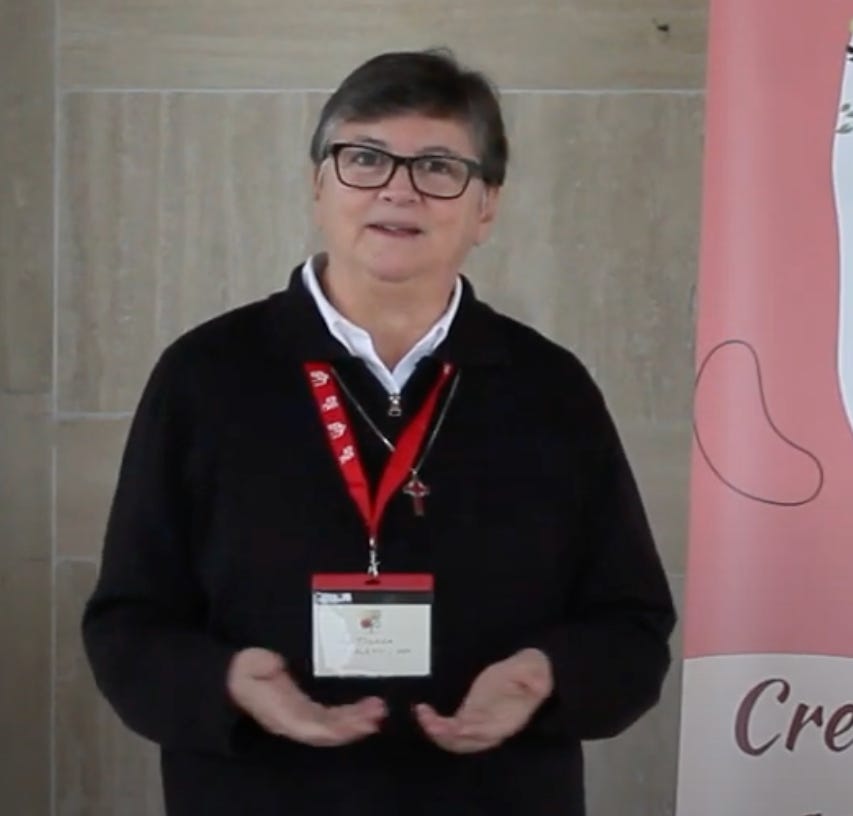Leo’s Feminized Vatican: Where Nuns Rule Priests
Leo XIV completes the revolution Francis began, and Rome no longer hides its inversion of sacred hierarchy
Sister Tiziana Merletti: Leo’s new Secretary for the Dicastery for Institutes of Consecrated Life and Societies of Apostolic Life
Pope Leo XIV’s early papacy has confirmed what faithful Catholics feared: the soft traditionalism of his vestments is a veil for the continuation and now the consolidation of the revolution begun at Vatican II.
Nowhere is this clearer than in his appointment to the Dicastery for Institutes of Consecrated Life and Societies of Apostolic Life, where both the Prefect (Sister Simona Brambilla) and now the Secretary (Sister Tiziana Merletti) are women religious. For the first time in Church history, a Roman dicastery with jurisdiction over male clergy is governed entirely by women.
This is a continuation of a radical, public, and systematic rupture with Catholic theology.
A Juridical Break with the Past
Traditionally, roles of ecclesiastical governance, especially over clergy, have been tied to the sacrament of Holy Orders, a priestly character men alone may receive. The Church has always taught that only those who share in the ministerial priesthood possess the authority to govern in the name of Christ.
The 1917 Code of Canon Law barred laymen and women alike from exercising jurisdiction over clergy. Even after the 1983 revision, which softened some restrictions, the tradition remained that major governance roles in the Roman Curia were reserved for ordained men. For centuries, this wasn’t debated. It was simply understood: Christ did not institute a Church where women govern priests.
Papal Witness: Leo XIII and John Paul II
Pope Leo XIII, in his writings and magisterial acts, consistently upheld the divine structure of the Church. He taught that governance flowed from the sacrament of Orders and that the Church has no authority to change what Christ Himself instituted.
John Paul II reaffirmed this doctrinal limit in Ordinatio Sacerdotalis
“The Church has no authority whatsoever to confer priestly ordination on women, and this judgment is to be definitively held by all the faithful.”
What flows from this is obvious: if women cannot be priests, then they cannot lawfully govern those who are. To suggest otherwise is not just a theological novelty, but a betrayal of divine constitution.
And yet under Leo XIV, two religious sisters now rule over entire congregations of male clergy and religious superiors.
Leo’s Church: Managerial, Feminized, and Synodal
This is not merely about roles or functions. It is about the identity of the Church itself. The true Church is hierarchical, patriarchal, and sacramental because Christ made her so.
But the new religion, the conciliar church that now occupies Rome, rejects this.
It replaces fatherhood with management, hierarchy with synodality, and priestly authority with sentimental egalitarianism. It’s not an accident that both Brambilla and Merletti come from bureaucratic, canon law heavy backgrounds. This is about converting the Church into a technocratic apparatus, where sacramental character means nothing and one’s identity as a woman is a qualification for governance, not a theological limitation.
The Role of Leo and the Fingerprints of Francis and Prevost
While Francis appointed Brambilla, it was Leo XIV, then Cardinal Robert Prevost, who helped shepherd her rise. As Prefect for the Dicastery for Bishops, Prevost supported female participation in episcopal selection, defended the Synod’s inclusion of women voters, and praised the “female perspective” in Church governance.
Now, as pope, he has completed the picture by appointing Merletti under Brambilla, solidifying the first-ever Vatican office wholly governed by non-ordained women over clergy.
Reports from U.S. News, Catholic Culture, OSV, and NCR all confirm the expectation that Leo XIV is just getting started. While he insists that women will never be ordained priests, he is perfectly willing to let them exercise practical authority over those who are. It is priestly function without priestly form.
And now, as NCR speculates, he may be the one to greenlight female deacons, not by restoring a fictional ancient order but by inventing a new one.
Theological Fallout: Scripture, Tradition, and Reason All Denied
Nowhere in Scripture do women exercise authority over clergy. The Apostle Paul forbade women to teach or govern men within the Church (1 Tim 2:12). Our Lady herself, highest among all creatures, never governed apostles.
To now claim that religious sisters can canonically rule over priests because they’re competent administrators is to embrace a functionalist Protestant ecclesiology that collapses hierarchy into mere management.
It is not Catholic.
It is not apostolic.
It is not of God.
The True Church Remains
The faithful must face the truth. What is operating in Rome is not the visible mark of Christ’s hierarchical Church but its eclipse, a shell animated by modernist dogmas and feminist principles. A Vatican office ruled by women over clergy is not Catholic.
But the true Church remains where the faith is whole, where men ordained by Christ preach the Gospel, and where Our Lady’s humility is honored, not weaponized into a justification for power.
Until the divine order is restored, faithful Catholics will have no part in the Great Inversion.
We remain not in rebellion but in exile.
Not in rupture but in witness.
Awaiting the day when Rome will remember she is not a democracy of ministries, but the Bride of Christ. And no bride governs her groom.






But wait a second, I was reliably informed by Trad inc. that Provost was a stealth Traditionalist.
What next?